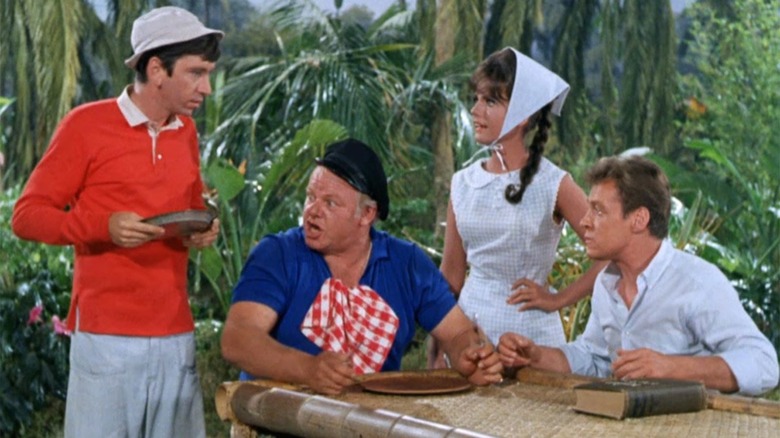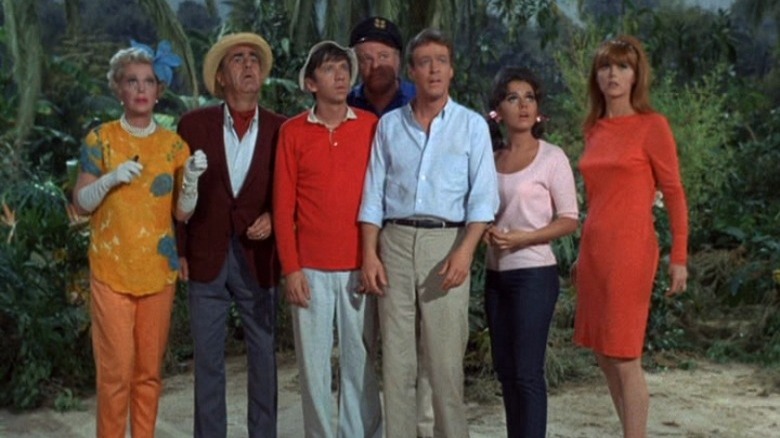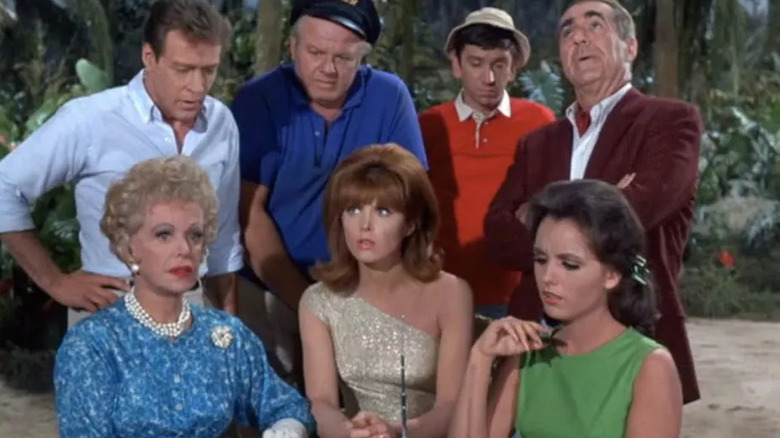There's A Gilligan's Island Novel That Puts A Dark Spin On The Characters We Love
The premise of Sherwood Schwartz's 1964 sitcom "Gilligan's Island" is succinctly laid out in its indelible theme song, written by Schwartz and George Wyle. The S.S. Minnow, helmed by Captain G. Jonas Grumby (Alan Hale) and his first officer Gilligan (Bob Denver) took on five passengers for a three-hour boat tour of Hawai'i. The ship hit some bad weather, got lost at sea, and washed up on an uncharted island somewhere in the Pacific. Now the two sailors, along with a millionaire (Jim Backus), his wife (Natalie Schafer), a movie star (Tina Louise), a professor (Russel Johnson), and a lottery-winning tourist (Dawn Wells), have to learn to survive, all to comedic effect.
"Gilligan's Island" has no themes of actual survival, instead rolling with its slapstick elements; the series clearly takes place in a cartoon reality. As such, the characters play as broad archetypes, mugging and screaming in an unrealistic fashion. Audiences, of course, love the "Gilligan's" characters for that very reason. Everything is expansively silly and the laughs come at pratfalls and foolishness, not stern analyses of humanity's tragic flaws.
"Gilligan's Island" became a camp bedrock of Gen-X pop culture, beloved and mocked in equal measure for its fluffy disposability. The series became the subject of parodies and satires, perhaps most notably when "Weird Al" Yankovic described the series in a spoof of Tone Lōc's "Wild Thing" called "Isle Thing." In 2003, however, the final word on "Gilligan's Island" parodies came with the publication of "Gilligan's Wake" by Tom Carson, the film and TV critic for Esquire Magazine. "Gilligan's Wake," taking its title from "Finnegans Wake," was an "exposé" of the characters on "Gilligan's Island," revealing that each one of them had a dark and shady past.
Gilligan's Wake
"Gilligan's Wake" is constructed in seven chapters, each one devoted to a different character. Despite the title, Tom Carson's book is not constructed in an abstract, circular fashion like James Joyce's original. Each chapter is, however, a style parody of an extant work of literature. The Gilligan chapter, for instance, emulates the stream-of-consciousness style of Thomas Pynchon's nuclear freakout "Gravity's Rainbow." The Gilligan chapter will also reveal that the "Island" characters all exist in a web-like fictional universe that intersects with multiple other 1960s sitcoms.
Gilligan, for instance, has disassociated and believes he is actually a man named Maynard G. Krebs (the character Bob Denver played on "The Many Loves of Dobie Gillis" in 1959). Krebs is knocked unconscious while protesting in San Francisco and is revived by Dr. Kildare F. Troop (a reference to the shows "Dr. Kildare" and "F Troop"). Dr. Troop tells him that his real name is not Krebs but ... well, something else. The story ends with Krebs undergoing shock therapy.
The Skipper, it is revealed, served on a PT Boat during the Pacific War, serving with both Quinton McHale (from "McHale's Navy") and a young JFK. While lost at sea on a side-mission, the Skipper's ship's engine becomes tangled up with ... well, something one might find in an episode of "Tales from the Crypt."
Mr. Howell, meanwhile, clashes with his son over their growing Communist sentiment in the early 1960s. Mr. Howell was friends with the real-life Alger Hiss, and has grown despondent over the state of his marriage. Mrs. Howell has had affairs behind his back. Mrs. Howell grew up in the jazz age, wealthy, and unable to form healthy relationships. She used to do morphine with Daisy Buchanan (from "The Great Gatsby") and the two became lovers.
Gilligan's Tragedy
Ginger's tale is a psychosexual drama that follows her from her racist Alabama home to a Hollywood career posing for bondage photographs. That leads to a career in sex work before a shift to B-movies. In a dark twist, she ends up having a brief affair with a man who turns out to be ... well, it's dark. Ginger also hangs out with a young JFK and the Rat Pack.
It's worth noting that each of the stories involves a cameo by Maxwell House products. Characters frequently drive past billboards for Maxwell House, "Krebs" protests Maxwell House, and the Howells drink Maxwell House coffee. Maxwell House had a huge TV advertising presence on CBS in the 1960s when "Gilligan's Island" was on the air, and might be the first product featured in on-air TV product placement (in the 1949 series "Mama"). In Carson's book, Maxwell House commercials seem to have been folded into the reality of the "Island" characters' lives. One might be put off-balance by a Maxwell House ad from the 1930s that featured a very Skipper-like character. Where does reality end and fantasy begin?
The stories continue apace. The Professor worked on the atom bomb that destroyed Nagasaki, while Mary-Ann goes through a magical, centuries-long voyage. Her village is like Brigadoon, in that it only appears on Earth once every century. She fled her town, dated Jean-Luc Godard, and possesses Wolverine-like healing powers. She also converses with a man — who may be her father — named Gil Egan.
The New York Times gave "Gilligan's Wake" a positive, if qualified, review, saying that it wasn't as good as "Finnegans Wake," but was certainly better than "Gilligan's Island." Pop culture was effectively torn down by Carson's book, and it may be worth a look.


